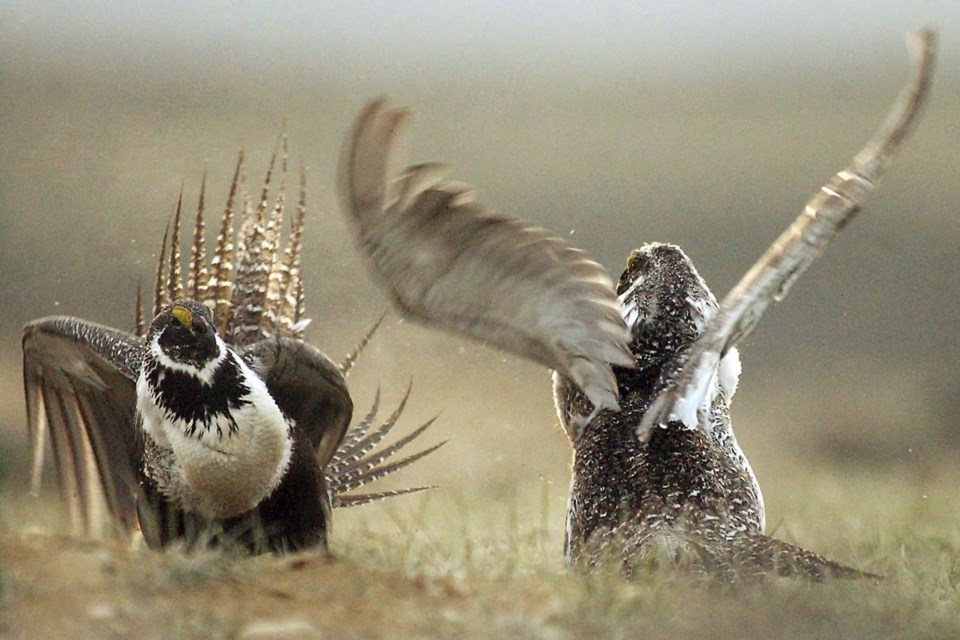BILLINGS, Mont. (AP) — President Joe Biden's administration on Friday proposed on oil, solar and wind energy development across more than 6,500 square miles of federal land in the U.S. West to protect a declining bird species.
However, it is doubtful the changes would survive under .
Greater sage grouse — chicken-sized birds known for an elaborate mating ritual— were once found across much of the U.S. West. Their in recent decades because of energy exploration, wildfires, disease and other pressures.
A 2015 agreement shepherded by the Obama administration kept the birds off the endangered species list, by imposing limits on where and when development could occur across their 270,000-square mile range.
Now officials with the Interior Department want to make the protections even stronger. Their plan would eliminate loopholes that allowed development in areas considered crucial to the bird's long-term survival. New solar and wind projects would be excluded, and oil and gas exploration could only occur from drilling platforms located outside the protected areas.
Trump has pushed to open more public lands to energy development in line with his mantra to “drill baby drill.” During his first administration, officials attempted to scale back the Obama-era sage grouse protections, but they were
Interior Secretary Deb Haaland said Friday's proposal would boost sage grouse while allowing development on some government lands to continue. She said the plan was based on the best science to protect the bird.
“For too long, a false choice has been presented for land management that aims to pit development against conservation,” Haaland said in a statement.
Yet the agency's attempt to find a middle ground fell flat with environmentalists, industry representatives and Republican elected officials.
Most of the land at issue — about 4,700 square miles — is in Nevada and California, according to government documents. Affected parcels also are in Wyoming, Oregon, Idaho, Colorado, Montana and the Dakotas.
Wyoming Gov. Mark Gordon lamented what he called the administration's “extreme indifference” to his state. The Republican governor said new layers of federal regulation would hinder practical solutions for the grouse.
“We have shown how to successfully manage this bird and do so in a way that allows for protection of core habitat alongside responsible development,” Gordon said.
Environmentalists, meanwhile, said officials had squandered a chance to put in place meaningful protections that could halt the grouse's slow spiral towards extinction. They noted that loopholes allowing development would remain in place across nearly 50,000 square miles of public lands.
“It's death by a thousands cuts,” said Greta Anderson with Western Watersheds Project, an environmental group involved in previous sage grouse lawsuits. “The Biden administration could have stopped the cutting, and it didn't. The fact that it's less bad doesn't mean it's not bad.”
Federal officials predicted only minimal economic impacts. They said energy companies already steer clear of sage grouse habitat, where there are limits on when and where work can be done near breeding areas. Those companies can still find opportunities on other public lands, the officials said.
That was disputed by an energy industry representative. Kathleen Sgamma with the Western Energy Alliance said the Biden administration already had limited leasing in sage grouse habitat.
“So they’ve denied access and then say companies are avoiding them anyway,” Sgamma said. “That’s disingenuous.”
The Interior Department's Bureau of Land Management will accept protests against Friday's proposal until Dec. 9. Final decisions on changes to the agency's land management plans will be made after the protests are resolved.
A related proposal to help sage grouse would block for 20 years new mining projects on more than 15,625 square miles in Idaho, Montana, Nevada, Oregon, Utah and Wyoming. That proposal was part of the 2015 Obama-era protections. It was canceled under Trump then restored by a court.
An analysis of the mining ban will be published by the end of the year, according to the Interior Department.
Greater sage grouse once numbered in the millions across all or portions of 11 Western states. Populations have according to government scientists.
Matthew Brown, The Associated Press




